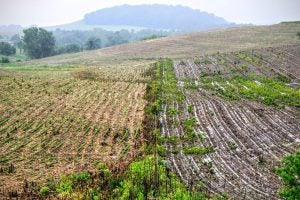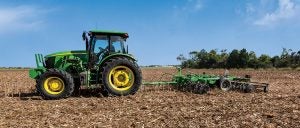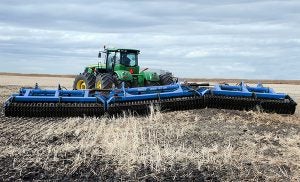The smell of broken of earth is one never forgotten by those who call themselves farmers. Tillage is the manipulation of soil and is an essential component of any farm strategy. But too often producers rely on tradition rather than information. As the reduction of greenhouse gasses emitted and the battle against drought become more essential, producers will need to reconsider the ways they expose their fields to the elements and conserve both water and topsoil. That means knowing about the various types of tillage available and what different kinds of tilling options mean for a specific operation.
Local extension agents are a great resource when it comes to investigating new ways to break the earth, and better technology is being born every day for just this purpose. From the ancient days of stone plows drawn by animals to the moldboard plow, to the chisel plow, to modern tractors with discs controlled by artificial intelligence, tillage remains.
Below is a breakdown of many of the types of tillage common today and the terms to consider when discussing new strategies for an operation — large or small. Frankly, a home gardener and commercial producer both employ tillage strategies and there’s quite a bit of crossover at the conceptual level. Tillage systems can also be found both in organic and conventional agriculture. But that said, many producers (particularly conventional growers) have shifted to no-till farming, which is crop production without disturbing the soil through tillage.

How much of what kind of tillage, and which tools to use, can make a tremendous difference in the yields. As a greater number of U.S. acres suffer drought-like conditions and greenhouse gasses are growing concern, there’s no question that tillage strategies will continue to be a hot topic in this 21st century.
What’s the Difference in Terms?
Any kind of tilling loosens the soil. This mechanical manipulation of earth is done for the purpose of managing crop residue, incorporating amendments, preparation of the seedbed, weed control, and removal of surface compaction and rutting.
To that degree, there are Primary Tillage and Secondary Tillage strategies to consider.
Primary tillage loosens the soil and mixes in fertilizer or plant material, producing a rougher textured soil. This is typically done after the last harvest. The primary objective here is to attain a reasonable depth of soft soil and incorporate crop residues and aerate the soil.
Secondary tillage producers a finer soil and sometimes shapes the rows in preparation of a seed bed and ensure weed control throughout the growing season. Secondary tillage is any subsequent tillage to incorporate fertilizers, reduce the soil to a finer texture, level the surface, and control weeds.

Vertical tillage refers to strategies where the tool enters and exits the soil on a vertical plane as opposed to a horizontal one. The goal here is for the implements to engage the ground straight up and down with as little angle as possible to the soil surface. Vertical tillage is helpful when cutting and sizing the residue while mixing it into soil to convert organic matter. This style tends to reduce the chance of leaving secondary compaction layers as is done by horizontal movements.
Horizontal tillage is broadcast in nature as the term suggests and grates horizontal layers of soil with different densities. Both the traditional moldboard and chisel plows have historically served in this role. Newer methods, in one example, include the Kinze Mach Till. Horizontal tilling reduces the need for chemical weed control, and the soil at the surface is relatively uniform, easing planter performance. The downside is water produced by rainfall can move more rapidly across it and cause erosion (a significant loss of topsoil).
Conservation tillage refers to those strategies designed to conserve soil by reducing erosion. The goal is to leave at least 30 percent crop residue on the soil surface or at minimum 1,000 pounds per acre of small grain residue. This slows water movement and reduces erosion. Typically, these strategies are implemented along with others involving soil management and cover crops and, if done successfully, can yield great benefits. Tilling-wise, these strategies include mulch-till, ridge-till, and no-till. Mulch tillage means the uniform spreading of residue on the soil surface and planning the operations so as to achieve a prescribed volume. Ridge tilling strategies allow the farmer to create ridges or raised triangular beds. Ridge tilling is typically shallow and produces smooth peaks to keep planters in the same rows. No-till farming practices leave the soil undisturbed by tillage with residue left on the soil surface.
Strategies termed reduced tillage leave between 15 percent to 30 percent crop residue on the soil, or 500 to 1,000 pounds per acre of small grain residue. Intensive tillage leaves less than 15 percent crop residue or 500 pounds per acre of small grain residue. Intensive tillage is typically performed with traditional implements such as the moldboard and chisel plows.
Conservation Tillage
Conservation tillage is a term even non-farmers know by now. And many reports indicate it can lead to greater profitability. The goal of leaving a minimum of 30 percent crop residue and use of cover crops has spread since the late 1990s across the globe.
According to the U.S. Department of Agriculture’s 2020 report on land use practices, the switch is apparent.
In 2017 farms with less than 500 acres utilizing:
- No-till, 226,609 farms with 23.6 million acres
- Reduced tillage, 163,679 farms with 20.6 million acres
- Intensive tillage, 224,555 farms with 20.2 million acres
In the same year, farms with more than 2,000 acres utilizing:
- No-till, 10,996 farms with 40.8 million acres
- Reduced tillage, 10,147 farms with 35.1 million acres
- Intensive tillage, 8,078 farms with 28.8 million acres
The use of cover crops is a key component of conservation tilling. In 2017, 153,402 farms planted cover crops versus 133,124 in 2012, representing a 15 percent increase. The acres of cover crop increased by 50 percent, climbing to 15,390,674 in 2017, up from 10,280,793 in 2012.
» Related: The expert’s guide to cover crops
One of the big bonuses to conservation tillage is that which it does not do. Farmers have long noted that excessive soil tillage can cause degradation and compaction, as well as increased erosion. If done properly, reduced tillage strategies can lower operational costs such as fuel and wear and tear on tractors.
Knowledge is Power
When it comes to tillage strategy, consultation with an extension agent and other soil experts is key. Implement dealers can also be a big help. Each season brings a slightly different weather pattern, and this can make as big a difference as the soil types from region to region.
The USDA also affords a wealth of information, including its report Conservation-Practice Adoption Rates Vary Widely by Crop and Region, which shows some historical data up through 2015 in terms of national and regional adoptions of different tillage systems and crops.

Because tillage breaks open the earth and exposes it to the sun and wind, the danger to worsen a drought is ever-present. Also, ground must be shaped in such a way as to prevent runoff and taking precious topsoil downstream. The strategies for tilling land out west will therefore be different than in the Deep South or Midwest, and these differences will continue to evolve amid a changing climate.
According to the March 2022 U.S. Drought Monitor, in one vital example, drought conditions were severe in the states of Texas, Oklahoma, Oregon, Nevada, Utah, Montana, and New Mexico. More than 20 percent of land in the western U.S. were categorized as either extreme or exceptional drought.
No farmer needs a lecture on how this can impact an operation. During that month, more than 10 percent of the alfalfa hay ground was in drought zones, and this is on top of a historic year for drought there in 2021. The impact this has on prices for food and supplies up and down the supply chain is apparent as the livestock feed goes up with it.
In those western states, surface water-fed irrigated agriculture depends largely on snowpack, which as of spring 2022 was 10 percent to 15 percent below historical median, and 30 percent and 25 percent below in California and Oregon, respectively.
But what about Indiana, Illinois, or Mississippi? Every producer knows each acre handles water differently, and that’s where smart tillage practices come into play. Whether one breaks the earth with a chisel plow or uses cover crops really should vary with each operation, as farming is much an art as it is a science. Knowledge is power and keeping up with the industry will be crucial growing forward.
Brian Boyce is an award-winning writer living on a farm in west-central Indiana. You can see more of his work at the Boyce Group homepage.



